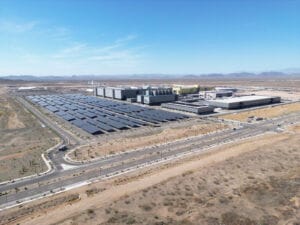The West Valley has become a magnet for a wide range of industries, including healthcare, advanced manufacturing and data centers, according to Buckeye Mayor Eric Orsborn.
“Today, the West Valley has a growing and diverse population, attracting professionals, families and businesses alike,” Orsborn says. “This creates vibrant communities and a robust pipeline for future development.”
It has also attracted thousands of new jobs, which has required the region to focus on the workforce of the future.
“Buckeye has led the way in sharing the ‘reverse the commute’ story, emphasizing the availability of skilled labor within the area,” Orsborn says. “The region has been successful in diversifying the industry base, moving from a bedroom community to attracting investments from companies such as Microsoft, Boeing and Amkor. As the region brings new jobs to the West Valley, every community benefits since these are career opportunities residents across the West Valley can take advantage of.”
Those economic development wins have also required a solid workforce development plan to assure those companies bringing billions of dollars in investments and thousands of new jobs to the West Valley that there is an eager and skilled workforce waiting to fill those jobs. To get a closer look at the region’s long-term vision and how the West Valley is building the workforce of the future, Az Business talked with Kevin Dumcum, director of workforce development for WESTMARC.
MORE NEWS: How the West Valley evolved into hotbed for innovation and growth
Az Business: What does a region need to do to develop a good workforce or to prepare the workforce of the future?
Kevin Dumcum: First, businesses need to be at the table and they need to tell us what they’re looking for. Too often, an agency — whether it’s government or nonprofit — will create a product to solve a problem and then present it to a business and it doesn’t quite meet what they need. So, we really need businesses to be engaged in the problem-solving to begin with so products or services are built to meet a specific need.
No. 2, I’m a huge proponent of work-based learning programs, where businesses take on apprentices or interns — hopefully paid — and also unpaid career technical education (CTE) programs. Businesses should be reviewing curriculum, providing staff who can teach the curriculum, and get engaged in their own workforce development, so they are driving the discussion and everything we do on the workforce supplier side be to build and meet their stated needs.
AB: Are there sectors that are doing a good job in helping develop their own workforce of the future?
KD: Construction has been doing it for decades. They are leading the apprenticeship charge. But what’s exciting is when I see our healthcare partners begin to explore what it would mean to create an apprenticeship programs within healthcare. They’re evaluating what the regulatory requirements are and how they can work within their regulatory requirements in professions like nursing. So, healthcare is getting involved with workforce development. We are looking to engage more manufacturing companies because their skilled needs are adjacent to construction, but they have historically not been very engaged with apprenticeship programs. Those three are probably the big ones: Construction, healthcare and manufacturing.
AB: What are the greatest strengths of the West Valley’s workforce in 2024?
KD: Our greatest strength is the strength of our education programs. I’ve been very impressed with our colleges, our community colleges, and the way that they have adopted the ability to pivot and to create non-degree programs. Five or 10 years ago, that would’ve been a non-starter. But our colleges and universities are becoming very adaptive with creating non-credit programs.
Businesses are recognizing that what they need are skills and not necessarily a degree. So, if you can get a skill in six months or a year as opposed to spending two years or four years working toward a degree, then you’re that much further ahead in your career.
And for those who are interested in pursuing a degree, ASU’s West Valley campus now offers undergraduate degree programs that prepare them for the increasing number of technology and engineering opportunities that are available in the West Valley.
AB: What is the West Valley doing right when it comes to developing the workforce for the future?
KD: One of the things a number of the cities is doing is offering scholarship opportunities to residents. Offering scholarships removes a barrier for West Valley residents and makes it easier for residents to take classes and stay relevant in the workforce. A lot of businesses are also offering scholarships through their foundations. So, that is very encouraging.
AB: Where are the greatest opportunities for young people to start a career or build a career in the West Valley?
KD: Because the West Valley is growing so rapidly and our economic base is so diverse, it really is pretty wide open. One of the sectors that offers tremendous opportunities is healthcare because our population is growing and healthcare is diversifying as new technology becomes available. There’s also manufacturing with Taiwan Semiconductor Manufacturing Company coming into the West Valley and KORE Power coming into Buckeye. With the support agencies that will come in with both of those companies, manufacturing is going to be growing exponentially. Our business services sector — professional services, financial finances, insurance, real estate, attorneys — is one of the West Valley’s biggest industries. They’re small businesses and a lot of them are entrepreneurs, but you add them all up and the business services sector is the West Valley’s biggest source of employment.
AB: So, small businesses are big business in the West Valley?
KD: Our entrepreneur ecosystem is thriving and our technology ecosystem is thriving. When we began to track West Valley technology startups in 2018, we had one. Now, we’re well into double digits year over year and growing the number of technology startups by 30% to 40% each year. That may be one person working in a garage, but eventually they’re going to scale and start to expand, and then they’re going to be hiring. So, that’s very exciting for the West Valley.
AB: What are some of your goals as director of workforce development for WESTMARC?
KD: One is continue to work on creating pathways for businesses to engage with workforce development. The corollary to that, and the other side to that coin, is finding ways to coordinate the needs of businesses with our workforce development ecosystem. There are ways we can do that where everybody wins.
One thing I tell businesses is don’t try to do it alone. Gone are the days where you just post a position on Indeed and hope you get enough candidates because you’re looking for a unicorn, and unicorns aren’t going through those channels. So get some help. Help and guidance is available from WESTMARC and other agencies at no cost or very low cost. And if a particular agency isn’t able to help, we all talk to each other, so we can point you in the right direction. But, reach out for help.




